Introduction to Published Papers
“Three-dimensional crescent-shaped ion velocity distributions created by magnetic reconnection in the presence of a guide field”
Shunsuke Usami, Seiji Zenitani
Physics of Plasmas 31, 022102 (2024),
DOI:10.1063/5.0171785
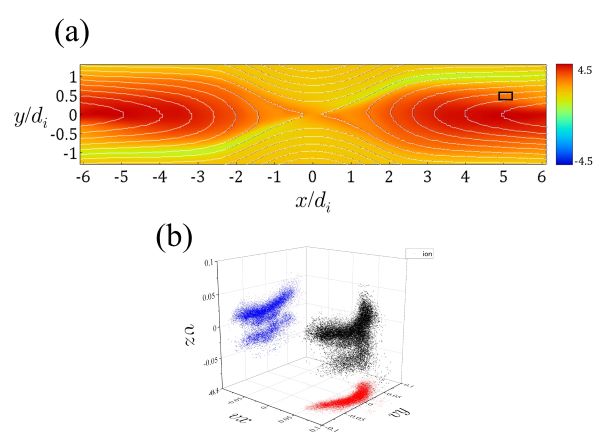
Crescent-shaped velocity distributions have been observed by satellites in the Earth’s magnetosphere since 1990s and analytical theories recently have been proposed. Consequently, it has been believed by many researchers that magnetic field reversal is necessary to production of crescent distributions. We, however, challenge the above accepted notion. We construct a new theory which indicates that crescents are constructed under a uniform magnetic field alone. It implies that magnetic field reversal is not required for crescents. Furthermore, according to our theory, three-dimensional crescents are formed by combination of uniform and reversed components of the magnetic field. We carry out particle simulations of magnetic reconnection with a strong guide field. Figure (a) shows the magnetic field lines and the guide magnetic field Bz, and Fig. (b) displays velocity plots of ions in the boxed area of Fig. (a). A three-dimensional crescent is clearly seen. We expect that 3D crescent-shaped ion velocity distributions will be detected in the outflow region of magnetic reconnection with a guide magnetic field at the Earth’s magnetopause.
“Enhanced Classical Radiation Damping of Electronic Cyclotron Motion in the Vicinity of the Van Hove Singularity in a Waveguide”,
Yuki Goto, Savannah Garmon, Tomio Petrosky,
Progress of Theoretical and Experimental Physics 2024, 033A02 (2024)
We study the damping process of electron cyclotron motion and the resulting emission in a waveguide using the classical Friedrichs model without relying on perturbation analysis such as Fermi’s golden rule. A Van Hove singularity appears at the lower bound (or cutoff frequency) of the dispersion associated with each of the electromagnetic field modes in the waveguide. In the vicinity of the Van Hove singularity, we found that not only is the decay process associated with the resonance pole enhanced (amplification factor ∼104) but the branch-point effect is also comparably enhanced. As a result, the timescale on which most of the decay occurs is dramatically shortened. Further, this suggests that the non- Markovian branch-point effect should be experimentally observable in the vicinity of the Van Hove singularity. Our treatment yields a physically acceptable solution without the problematic runaway solution that is well known to appear in the traditional treatment of classical radiation damping based on the Abraham–Lorentz equation.
“Young’s double-slit experiment with undulator vortex radiation in the photon-counting regime”,
Shin-ichi Wada, Hiroyuki Ohta, Atsushi Mano, Yoshifumi Takashima, Masaki Fujimoto, Masahiro Katoh,
Scientific Reports, 13, 22962 (2023)
DOI: 10.1038/s41598-023-49825
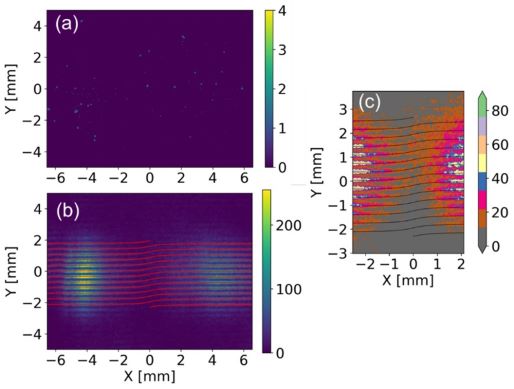
Results of Young’s double-slit interference experiment for optical vortex radiated from ultra-relativistic electron. (a) is a single captured image taken over a short period of time, and when 5000 images are stacked together, the result in (b) is obtained. In (c), where the dark area in the center is made more visible, characteristic distortions in the interference fringes that are expected for optical vortex but not for normal light are observed.
“Molecular dynamics simulation on fabrication of chiral nanoneedle by optical vortex”,
Hiroaki Nakamura, Shu Habu,
Japanese Journal of Applied Physics 62, SA1013 (2023)
DOI:10.35848/1347-4065/ac91d
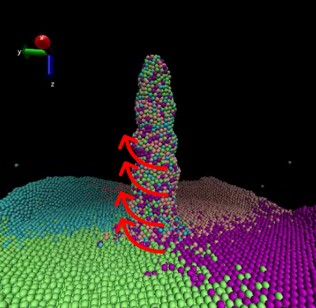
It has been experimentally reported that irradiating tantalum with an optical vortex laser having orbital angular momentum transfers angular momentum from the electromagnetic field to the tantalum atoms, resulting in the formation of chiral nanoneedle structures. We have reproduced the formation of chiral nanoneedle structures in tantalum as shown in the figure using molecular dynamics simulations in which a “force” simulating the interaction between the electromagnetic field and the atoms is applied to the tantalum atoms. We also confirmed that the orientation of the chiral structure depends on the orbital angular momentum of the optical vortex.
“Correlation of the orthogonal basis of the core plasma distribution to the divertor footprint distribution in LHD”,
H. Tanaka, S. Masuzaki, G. Kawamura, Y. Hayashi, M. Kobayashi, Y. Suzuki, K. Mukai, S. Kajita, N. Ohno,
Plasma and Fusion Research 18, 2402021 (2023)
DOI: 10.1585/pfr.18.240202
We have applied the multivariable analysis technique called the proper orthogonal decomposition (POD) to both the divertor particle flux distribution and the electron pressure distribution in the core region of LHD. The cross-correlation analysis indicates that 3rd, 4th, and 5th POD modes of the electron pressure distribution are highly correlated with the divertor footprint index which is a measure of where the peak position of the particle flux distribution is located on the inner divertor plate. Both the 3rd and 4th modes seem to correspond to the shift of the electron pressure peak position from the magnetic-axis radius. In contrast, 5th mode has a strong influence on the peripheral gradient of the electron pressure distribution. Their relationships with the divertor footprint could be explained by the finite β and the Pfirsch-Schlüter current effects.
“Enhancement of Doppler spectroscopy to transverse direction by using optical vortex”
Hiroki Minagawa, Shinji Yoshimura, Kenichiro Terasaka, Mitsutoshi Aramaki
Scientific Reports 13, 15400 (2023)
DOI: 10.1038/s41598-023-42517-
Tunable diode laser absorption spectroscopy (TDLAS) is a valuable method for measuring particle flow velocities in plasma. However, conventional TDLAS using a plane-wave beam is sensitive only to the laser propagation direction. This limitation is particularly unfavorable for the observation of the particle transportation perpendicularly incident on the material in the plasma–material interaction. In this paper, we show for the first time that flow measurements perpendicular to the beam direction are possible by replacing the probe beam with an optical vortex beam. Because an optical vortex has a helical wavefront, particles moving in its field experience an azimuthal Doppler shift in addition to the translational Doppler shift. Assuming a uniform gas flow across the optical vortex, the azimuthal Doppler shift of the absorption spectrum observed in the beam cross-section varies sinusoidally in the azimuthal direction. The transverse flow velocity is derived from the amplitude of this sinusoidal variation. At transverse velocities above 70 m/s, the measurement errors are found to be less than 15%, with a mean absolute percentage error of less than 8%.
“Generation and measurement of low-temperature plasma for cancer therapy: a historical review”
Kenji Ishikawa, Keigo Takeda, Shinji Yoshimura, Takashi Kondo, Hiromasa Tanaka, Shinya Toyokuni, Kae Nakamura, Hiroaki Kajiyama, Masaaki Mizuno, Masaru Hori
Free Radical Research 57, 239-270 (2023)
DOI: 10.1080/10715762.2023.223035
This review provides a description of the historical background of the development of biological applications of low-temperature plasmas. The generation of plasma, methods and devices, plasma sources, and measurements of plasma properties, such as electron dynamics and chemical species generation in both gaseous and aqueous phases, were assessed. Currently, direct irradiation methods for plasma discharges contacting biological surfaces, such as the skin and teeth, are related to plasma biological interactions. Indirect methods using plasma-treated liquids are based on plasma–liquid interactions. The use of these two methods is rapidly increasing in preclinical studies and cancer therapy. The authors address the prospects for further developments in cancer therapeutic applications by understanding the interactions between the plasma and living organisms.
“Investigation of the magnetic field configuration for magnetic surface measurements in the CFQS quasi-axisymmetric stellarator”,
M. Shoji, A. Shimizu, S. Kinoshita, S. Okamura, Y. Xu, H. Liu,
Plasma and Fusion Research 18, 2405026 (2023)
DOI:10.1585/pfr.18.240502
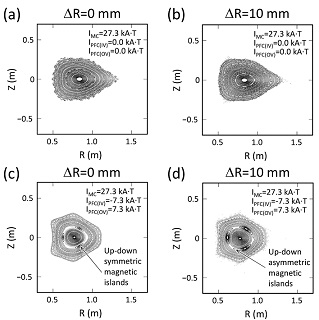
Figure (a) shows the calculation of the magnetic surfaces in a typical magnetic configuration in CFQS. Figure (b) presents the calculation where the position of one modular coil is horizontally shifted toward the outboard side of the tours by 10 mm. Both are almost identical, which means that magnetic surface measurements in this typical configuration cannot detect the displacement of the coils. Figure (c) indicates the calculation in the configuration dedicated to the magnetic surface measurements, in which magnetic islands are formed in the middle of the plasma confinement region. Figure (d) illustrates the calculation where one modular coil is shifted by 10 mm in this configuration, in which the magnetic islands change to up-down asymmetric. Thus, the magnetic surface measurements in this configuration can detect the displacement of the coils.
“Development of an experimental system for cell viability assays of yeasts using gas-temperature controllable plasma jets” ,
Shinji Yoshimura, Yoko Otsubo, Akira Yamashita, Katsuki Johzuka, Takayoshi Tsutsumi, Kenji Ishikawa, Masaru Hori,
Japanese Journal of Applied Physics, 62, SL1011 (2023)
DOI:10.35848/1347-4065/acd4ca
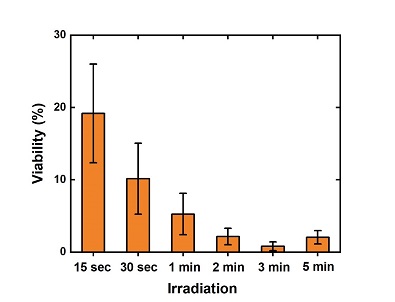
Cell viability of wild-type fission yeast cells against various plasma irradiation durations. The recent establishment of generation methods for low-temperature atmospheric pressure plasma has enabled the direct irradiation of plasma to living organisms. However, biologists have pointed out that it is not enough to merely irradiate at a physically tolerable temperature; it is essential to irradiate at a temperature suitable for the organism’s growth. Therefore, we have developed a plasma jet source that can irradiate at room temperature by cooling the feeding gas with a Peltier device. Using this plasma jet, we developed an experimental system for cell viability assays, indispensable for basic biology experiments. The figure shows the survival rate of fission yeast cells for various irradiation durations. This enables the search for genetic mutants that are resistant or vulnerable to plasma irradiation. In addition, various measurements, including optical emission spectroscopy, vacuum ultraviolet absorption spectroscopy, and thermography, were used to evaluate the characteristics of this room-temperature plasma in this paper.
* By using this experimental system at the National Institute for Basic Biology, genes involved in plasma resistance have recently been identified, and a paper is currently being submitted.
